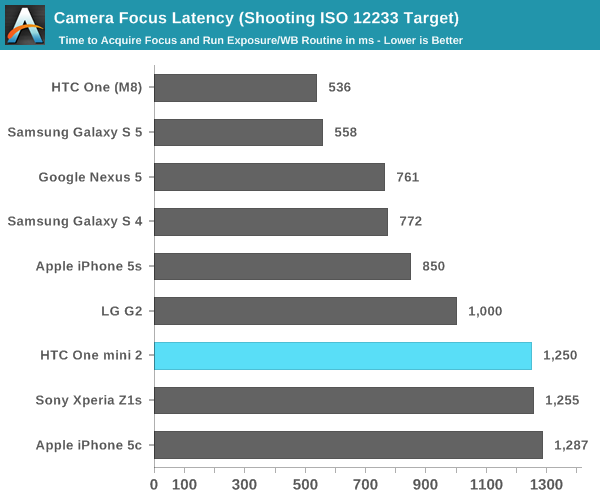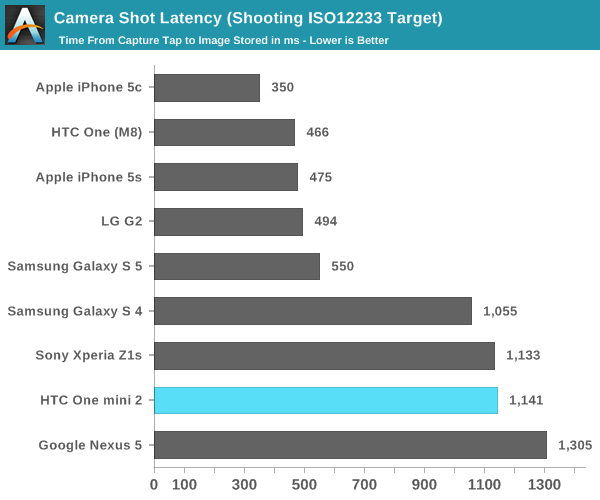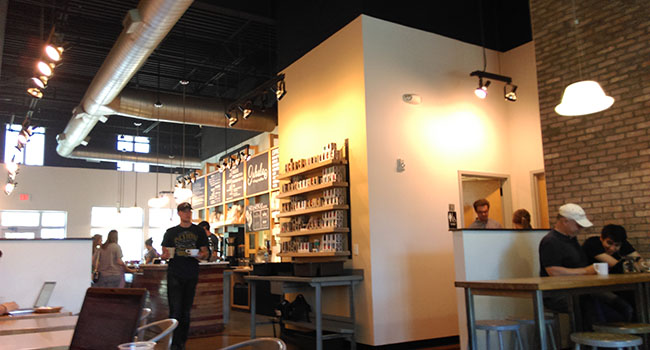HTC One mini 2 Review
by Anand Lal Shimpi & Joshua Ho on May 26, 2014 3:00 AM EST- Posted in
- Smartphones
- HTC
- Mobile
- One mini 2
Focus & Capture Latency
Although image quality is a (big) part of the camera experience, camera UI and capture latency in particular are quite important. Long focus and capture latencies can really ruin the overall experience, not just from a responsiveness standpoint but also by contributing to missing a shot. At the very high end, devices like the One (M8) and Galaxy S 5 rely on external companion chips to improve focus times. In the transition to a lower price point, the One mini 2 loses any external imaging aids.
Though the camera UI looks similar to the M8's, it's very obvious that both focus and capture latency are substantially longer on the One mini 2. To quantify the difference I turned to the set of tests we introduced in the Galaxy S 5 review.
First let's look at focus time. I measured from the moment I tapped the focus target to the time the image stopped moving (I didn't rely on the AF lock indicator as some devices report focus lock prematurely). There's a bit more variance than I'd normally like in these numbers due to the nature of the capture, although I'm working on getting a higher speed camera to smooth some of that out.

The lowest focus latency I saw on the mini 2 was 850ms, but on average I saw around 1.2 seconds from tap until focus lock. That's about the speed of an iPhone 5c, but substantially slower than other similarly priced devices like the G2.
Focusing is just one piece of the puzzle, I also measured capture latency as well. I had to modify my criteria for measuring latency here a bit. Previously I just looked at the time between when I tapped the capture button on the screen and when the camera UI was ready to take another shot. For all other devices, that metric worked out fine - the mini 2 behaves a bit differently. The UI is responsive after about 250ms. In fact, on the mini 2 you can queue up to three captures in a row. The problem is the image captured won't be committed to NAND (and thus unavailable for review) until around 1100ms after you hit the capture button. The UI is still responsive during that time, but you haven't really completed a capture. What I'm looking at in the graph below is the time between capture tap and the image being stored.

The One mini 2 takes a bit over a second to complete a capture, which definitely hampers the experience. HTC does a good job of keeping the UI feeling responsive though. If you don't mind the image actually not being committed to NAND, the mini 2 provides the appearance of a 250ms capture latency.
This next chart combines the previous two values to give an overall picture of capture latency on these devices:

The One mini 2 ends up being our slowest device here. Even if you use the lower value for capture time, the mini 2 ends up around the middle of the pack. I suspect the Snapdragon 400's ISP definitely hampers performance here.
Still Image Summary
The One mini 2 definitely has the ability to deliver more detailed photos than the One (M8) in well lit scenes. For landscape shots or photos where a detailed subject is far away, the One mini 2 maintains an advantage over the M8. With subjects up close however, the advantage is far less pronounced and in many cases goes back to the M8:


Any advantage in spatial resolution the mini 2 maintains however comes at the expense of low light performance, which is more or less nonexistant on the mini.
In shooting with the mini 2 I definitely noticed more issues with blurring at the corners and a lack of uniformity overall, which is usually what we get with lower cost camera modules. Even my M8 sample shows more distortion on one side of the module than on the other.
Compared to other similarly priced devices, the One mini 2 generally falls behind in still imaging performance. You can find LG's G2 for around $400 now, which not only produces better photos in well light scenes but much better photos in low light as well.
Capture latency is also worse on the mini 2 compared to the M8. Focus and capture times are longer than previous generation flagships like LG's G2 as well. Despite the long capture time however, HTC does a good job of making the camera UI still feel responsive.
Video
The One mini 2 can capture high profile H.264 at 1080p30 with an average bitrate just south of 20Mbps. The device can also capture captures H.264 (baseline profile) video at 720p30 with an average bitrate of 11.8Mbps.

Video quality isn't particularly great, but it's usable so long as there's sufficient light.










76 Comments
View All Comments
devione - Monday, May 26, 2014 - link
Why, oh why, can't more manufacturers follow the Sony Z1 Compact route..Johnmcl7 - Monday, May 26, 2014 - link
I'd be interested to see the sales figures for the Z1 Compact in Europe where the phone is widely available to see if Sony's strategy of producing a flagship phone with a smaller screen has worked out for them. On paper the phone looks pretty much exactly what everyone has been wanting for a while in Android with a top end SoC, camera, micro SD, decent screen even weather sealing and without much compromise either as the price is reasonable as is the batterylife. It makes a complete mockery of the HTC Mini 2 as they both appear to be a similar price despite the Sony being a much more capable device.Yet I've not seen anyone with a Z1 Compact despite plenty of other Android phones and I've hardly seen any second hand for sale (I want a cheap one for going out cycling) whereas there's quite a few S5's around even though it's only recently released. I realise none of that's statistically relevant hence I'd like to see the sales data.
I do think Sony were too slow releasing the Z1 Compact, I think if they'd released it around two years after the Galaxy S2 they'd have been in the perfect position to catch those who wanted a similar sized phone with top end specs. I knew quite a few people who had S2's and didn't want an S4 due to the increase in size however as there wasn't anything suitable in a smaller form factor with Android they went with the S4 and find the size is fine.
A few friends and family have 'mini' phones particularly the S3 Mini and S4 Mini but they didn't just want a smaller phone they also wanted a cheap phone so wouldn't have considered a Z1 Compact if available.
Laxaa - Monday, May 26, 2014 - link
My brother just bought the Z1 Compact, and it's an impressive piece of kit. I only wish it had OIS and a better camera app(like Nokia Camera on the Lumias)Death666Angel - Monday, May 26, 2014 - link
From the article: "HTC then proceeded to launch the One mini, a phone that was the size that everyone had been asking for"From Johnmcl7: " On paper the phone looks pretty much exactly what everyone has been wanting for a while in Android".
Really? Everyone wanted a phone like that? I didn't. I was fine with 4.3" in my SGS2 when the iPhone established the 3.x" form factor. I liked my 4.65" Galaxy Nexus when that was becoming the norm and I like the 5.2" LG G2 which is doesn't feel much larger than the GN. So count me out of that "everyone" group, please. Not everyone is looking for smaller flag ship phones, just like not everyone is looking for microSD card slots, replaceable batteries or phones made out of aluminum. Some are, others aren't. I'm someone who is fine with lugging around his Nexus 7 when I'm wearing a jacket. The 5.2" G2 fits perfectly fine in all my trousers and I have never thought "bly me, that size is really bothering me".
Johnmcl7 - Monday, May 26, 2014 - link
OK, wrong turn of speech - my own phone is a Sony Z Ultra (6.4in screen) so I certainly appreciate the benefits of a larger screen.fokka - Wednesday, May 28, 2014 - link
i'm really happy for you and you're right, not "everyone" wants all those things you list. the problem is that for people who are happy with 5"+ phones there already are many options - the whole flagship-segment caters to them.but for those who want all the power in a slightly smaller form factor there is exactly one viable offering - not much considered the dozens/hundreds of models on the market. and even this lonely smartphone will be "obsolete" in a matter of months, considering the specs of current and coming flagships.
in a market like this, i think it's clear and also warranted, that people are complaining. but even if we aren't "everybody", it's still important that we voice our opinions. sorry if you felt collateralized ;)
sfuzzz - Monday, May 26, 2014 - link
I feel exactly the same. Z1 Compact is a great phone (with some flaws like other) and the right size for everyday life, you don't have to carry a bag or a jacket only for your phone. I own a Nexus 5, coming from a Xperia U (perfect size for me) and this summer will see if i go mad feeling it in my pockets all day. As for the sales (of Z1 compact) It's difficult to tell the real figures, here in Italy is available for 450/420 euros or less, but anything that is not Samsung or iPhone is a "niche" phone. I own a N5, my sister owns a Moto G, and we are considered some kind of "geeks" only for that :)Gich - Monday, May 26, 2014 - link
4xCortex-A7 can't keep up with 2xKrait 200 on benchmarks that do stress all core... and it should be worst on "normal" apps.Isn't this... very bad?
Gich - Monday, May 26, 2014 - link
Also "it’s not much of an improvement"? I feel is more of a step back.tipoo - Monday, May 26, 2014 - link
Yeah, I'd take dual krait over any number of A7 cores any day.